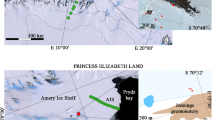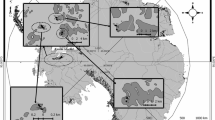Abstract
The diversity of yeast species collected from the bromeliad tanks of Vriesea minarum, an endangered bromeliad species, and their ability to produce extracellular enzymes were studied. Water samples were collected from 30 tanks of bromeliads living in a rupestrian field site located at Serrada Piedade, Minas Gerais state, Brazil, during both the dry and rainy seasons. Thirty-six species were isolated, representing 22 basidiomycetous and 14 ascomycetous species. Occultifur sp., Cryptococcus podzolicus and Cryptococcus sp. 1 were the prevalent basidiomycetous species. The yeast-like fungus from the order Myriangiales, Candida silvae and Aureobasidium pullulans were the most frequent ascomycetous species. The diversity of the yeast communities obtained between seasons was not significantly different, but the yeast composition per bromeliad was different between seasons. These results suggest that there is significant spatial heterogeneity in the composition of populations of the yeast communities within bromeliad tanks, independent of the season. Among the 352 yeast isolates tested, 282 showed at least one enzymatic activity. Protease activity was the most widely expressed extracellular enzymatic activity, followed by xylanase, amylase, pectinase and cellulase activities. These enzymes may increase the carbon and nitrogen availability for the microbial food web in the bromeliad tank of V. minarum. Sequence analyses revealed the existence of 10 new species, indicating that bromeliad tanks are important sources of new yeasts. The novel species Occultifur brasiliensis, f.a., sp. nov., is proposed to accommodate the most frequently isolated yeast associated with V. minarum. The type strain of O. brasiliensis, f.a., sp. nov. is UFMG-CM-Y375T (= CBS 12687T). The Mycobank number is MB 809816.




Similar content being viewed by others
References
Alves RJV, Kolbek J (2010) Can campo rupestre vegetation be floristically delimited based on vascular plant genera? Plant Ecol 207:67–79
Araújo FV, SoaresCA Hagler AN, Mendonça-Hagler LC (1995) Ascomycetous yeast communities of marine invertebrates in a southeast Brazilian mangrove ecosystem. Antonie Van Leeuwenhoek 68:91–99
Araújo FV, Medeiros RJ, Mendonça-Hagler LC, Hagler AN (1998) A preliminary note on yeast communities of bromeliad-tank waters of Rio de Janeiro, Brazil. Rev Microbiol 29:118–121
Araújo FV, Rosa CA, Freitas LFD, Lachance MA, Vaughan-Martini A, Mendonça-Hagler LC, Hagler AN (2012) Kazachstania bromeliacearum sp. nov., a yeast species from water tanks of bromeliads. Int J Syst Evol Microbiol 62:1002–1006
Benites VM, Schaefer CER, Simas FNB, Santos HG (2007) Soil associated with rock outcrops in the Brazilian mountain ranges Mantiqueira and Espinhaço. Rev Bras Bot 30:569–577
Boekhout T, Theelen B, Houbraken J, Robert V, Scorzetti G, Gafni A, Gerson U, Sztejnberg A (2003) Novel anamorphic mite-associated fungi belonging to the Ustilaginomycetes: Meira geulakonigii gen. nov., sp. nov., Meira argovae sp. nov. and Acaromyces ingoldii gen. nov., sp. nov. Int J Syst Evol Microbiol 53:1655–1664
Brandão LR, Libkind D, Vaz ABM, Santo LC, Moliné M, de García V, van Broock M, Rosa CA (2011) Yeasts from an oligotrophic lake in Patagonia (Argentina): diversity, distribution and synthesis of photoprotective compounds and extracellular enzymes. FEMS Microbiol Ecol 76:1–13
Brizzio S, Turchetti B, de García V, Libkind D, Buzzini P, van Broock M (2007) Extracellular enzymatic activities of basidiomycetous yeasts isolated from glacial and subglacial waters of northwest Patagonia (Argentina). Can J Microbiol 53:519–525
de García V, Brizzio S, Libkind D, Buzzini P, van Broock M (2007) Biodiversity of cold-adapted yeasts from glacial melt water rivers in Patagonia, Argentina. FEMS Microbiol Ecol 59:331–341
Edgar RC (2004) MUSCLE: multiple sequence alignment with high accuracy and high throughput. Nucleic Acids Res 32:1792–1795
Felsenstein J (1985) Confidence limits on phylogenies: an approach using the bootstrap. Evolution 36:783–791
Fleet GH (2011) Yeast spoilage of food and beverages. In: Kurtzman CP, Fell J, Boekhout T (eds) The yeasts: a taxonomic study, 5th edn. Elsevier, Amsterdam, pp 53–64
Fonseca A, Boekhout T, Fell JW (2011) Cryptococcus Vuillemin (1901). In: Kurtzman CP, Fell J, Boekhout T (eds) The yeasts: a taxonomic study, 5th edn. Elsevier, Amsterdam, pp 1661–1738
Givnish TJ, Barfuss MHJ, Van EB, Riina R, Schulte K, Horres R, Gonsiska PA, Jabaily RS, Crayn DM, Smith JAC, Winter K, Brown GK, Evans TM, Holst BK, Luther H, Till W, Ziska G, Berry PE, Sytsma KJ (2011) Phylogeny, adaptive radiation, and historical biogeography in Bromeliaceae: insights from an eight-locus plastid phylogeny. Am J Bot 98:872–895
Gofreddi SK, Kantor AH, Woodside WT (2011) Aquatic microbial habitats within a neotropical rainforest: bromeliads and pH-associated trends in bacterial diversity and composition. Microb Ecol 61:529–542
Guimarães-Souza BA, Mendes GB, Bento L, Marotta H, Santoro AL, Esteves FA, Pinho L, Farjalla VF, Enrich-Prast A (2006) Limnological parameters in the water accumulated in tropical bromeliads. Acta Limnol Bras 18:47–53
Hagler AN, Rosa CA, Morais PB, Hagler LCM (1993) Yeasts and coliform bacteria of water accumulated in bromeliads of mangrove and sand dune ecosystems of southeast Brazil. Can J Microbiol 39:973–977. doi:10.1139/m93-146
Humber RA (2008) Evolution of entomopathogenicity in fungi. J Invert Pathol 98:262–266. doi:10.1016/j.jip.2008.02.017
Inselsbacher E, Cambui CA, Richter A, Stange CF, Mercier H, Wanek W (2007) Microbial activities and foliar uptake of nitrogen in the epiphytic bromeliad Vriesea gigantean. New Phytol 175:311–320
Ippolito A, Ghaouth AE, Wilson CL, Wisniewski M (2000) Control of postharvest decay of apple fruit by Aureobasidium pullulans and induction of defense responses. Postharvest Biol Technol 19:265–272
Kurtzman CP, Fell JW, Boekhout T, Robert V (2011) Methods for isolation, phenotypic characterization and maintenance of yeasts. In: Kurtzman CP, Fell JW, Boekhout T (eds) The yeasts, a taxonomic study, 5th edn. Elsevier, Amsterdam, pp 97–107
Lachance MA (2012) In defense of yeast sexual life cycles: the forma asexualis—an informal proposal. Yeast Newsl 61:24–25
Lachance MA, Bowles JM, Starmer WT, Barker JSF (1999) Kodamaea kakaduensis and Candida tolerans, two new ascomycetous yeast species from Australian Hibiscus flowers. Can J Microbiol 45:172–177
Lanchance MA, Boekhout T, Scorzetti G (2011) Candida Berkhout (1923). In: Kurtzman CP, Fell J, Boekhout T (eds) The yeasts: a taxonomic study, 5th edn. Elsevier, Amsterdam, pp 987–1278
Landell MF, Mautone JN, Valente P (2006) Biodiversity of yeasts associated to bromeliads in ItapuãPark, Viamão/RS. Biociências 14:144–149
Landell MF, Inácio J, Fonseca A, Vainstein MH, Valente P (2009) Cryptococcus bromeliarum sp. nov., an orange-coloured basidiomycetous yeast isolated from bromeliads in Brazil. Int J Syst Evol Microbiol 59:910–913
Landell MF, Billodre R, Ramos JP, Leoncini O, Vainstein MH, Valente P (2010) Candida aechmeae sp. nov. and Candida vrieseae sp. nov., novel yeast species isolated from the phylloplane of bromeliads in Southern Brazil. Int J Syst Evol Microbiol 60:244–248
Landell MF, Brandão LR, Barbosa AC, Ramos JP, Safar SVB, Gomes FCO, Sousa FM, Morais PB, Boretto L, Leoncini O, Ribeiro JR, Fungsin B, Takashima M, Nakase T, Lee CF, Vainstein MH, Fell JW, Scorzetti G, Vishniac HS, Rosa CA, Valente P (2014) Hannaella pagnoccae sp. nov., a tremellaceous yeast species isolated from plants and soil. Int J Syst Evol Microbiol 64:1970–1977
Libkind D, Moliné M, Sampaio JP, van Broock M (2009) Yeasts from high-altitude lakes: influence of UV radiation. FEMS Microbiol Ecol 69:353–362
Lieckfeldt E, Meyer W, Borner T (1993) Rapid identification and differentiation of yeast by DNA and PCR fingerprinting. J Basic Microbiol 33:413–426
Lopez LCS, Alves RRD, Rios RI (2009) Micro-environmental factors and the endemism of bromeliad aquatic fauna. Hydrobiol 625:151–156
Loque CP, Medeiros AO, Pellizzari FM, Oliveira EC, Rosa CA, Rosa LH (2010) Fungal community associated with marine macroalgae from Antarctica. Polar Biol 33:641–648
Luther HE (2008) An alphabetical list of bromeliad binomials. The Bromeliad Society International Inc., Orlando
Magurran AE (2004) Measuring biological diversity. Blackwell Science Ltda, Oxford
Marques AR, Lemos-Filho JP (2008) Reproductive phenology of bromeliad species at Serra da Piedade, Minas Gerais state, Brazil. Acta Bot Bras 22:417–424
Mautone JN, Landell MF, Fuentefria AM, Valente P (2010) Phylloplane yeasts as a source of industrially interesting enzymes. R Bras Bioci 8:169–173
McNeill J, Barrie FR, Buck WR, Demoulin V, Greuter W, Hawksworth DL, Herendeen PS, Knapp FS, Makhold K, Prado J, Prud’homme van Reine WF, Smith GF, Wiersema JH, Turland NJ (2012) International Code of Nomenclature for algae, fungi, and plants (Melbourne Code). Regnum Vegetabile 154. Koeltz Scientific Books
Mestre CM, Rosa CA, Safar SVB, Libkind D, Fontenla SB (2011) Yeast communities associated with the bulk-soil, rhizosphere and ectomycorrhizosphere of a Nothofagus pumilio forest in northwestern Patagonia, Argentina. FEMS Microbiol Ecol 78:531–541
Muggia L, Hafellner J, Wirtz N, Hawksworth DL, Grube M (2008) The sterile microfilamentous lichenized fungi Cystocoleus ebeneus and Racodium rupestre are relatives of plant pathogens and clinically important dothidealean fungi. Mycol Res 112:50–56. doi:10.1016/j.mycres.2007.08.025
Reche I, Pulido-Villena E, Morales-Baquero R, Casamayor E (2005) Does ecosystem size determine aquatic bacterial richness? Ecology 86:1715–1722
Rosa CA, Péter G (2006) Biodiversity and ecophysiology of yeast (The Yeast Handbook). Springer, New York
Rosa LH, Vaz ABM, Caligiorne RB, Campolina S, Rosa CA (2009) Endophytic fungi associated with the Antarctic Grass Deschampsia antarctica Desv. (Poaceae). Polar Biol 32:161–167. doi:10.1007/s00300-008-0515-z
Ruivo CCC, Lachance MA, Rosa CA, Bacci M Jr, Pagnocca F (2005) Candida bromeliacearum sp. nov. and Candida ubatubensis sp. nov., two yeast species isolated from the water tanks of Canistropsis seidelli (Bromeliaceae). Int J Syst Evol Microbiol 55:2213–2217
Ryan GS, Harper DAT, Whalley JS (1995) PALSTAT, statistics for palaeontologist. Chapman & Hall, London
Safar SVB, Gomes FCO, Marques AR, Lachance MA, Rosa CA (2013) Kazachstania rupicola sp. nov., a yeast species isolated from water tanks of a bromeliad in Brazil. Int J Syst Evol Microbiol 63:1165–1168
Sampaio JP, Oberwinkler F (2011) Occultifur Oberwinkler (1990). In: Kurtzman CP, Fell J, Boekhout T (eds) The yeasts: a taxonomic study, 5th edn. Elsevier, Amsterdam, pp 1515–1518
Sampaio JP, Bauer R, Begerow D, Oberwinkler F (1999) Occultifur externus sp. nov., a new species of simple-pored auricularioid heterobasidiomycete from plant litter in Portugal. Mycologia 91:1094–1101
Schmidt G, Zotz G (2002) Inherently slow growth in two Caribbean species: a demographic approach. J Veg Sci 13:527–534
Tamura K, Stecher G, Peterson D, Filipski A, Kumar S (2013) MEGA6: molecular evolutionary genetics analysis version 6.0. Mol Biol Evol 30:2725–2729
Vánky K, Lutz M, Shivas RG (2006) Anomalomyces panici, new genus and species of Ustilaginomycetes from Australia. Mycol Balcan 3:119–126
Versieux LM (2011) Brazilian plants urgently needing conservation: the case of Vriesea minarum (Bromeliaceae). Phytotaxa 28:35–49
Versieux LM, Wendt T (2007) Bromeliaceae diversity and conservation in Minas Gerais state, Brazil. Biodivers Conserv 16:2989–3009
White TJ, Bruns TD, Lee SB (1990) Amplification and direct sequencing of fungal ribosomal RNA genes for phylogenetics. In: Innis NA, Gelfand J, Sninsky J (eds) PCR protocols: a guide to methods and applications. Academic Press, San Diego, pp 315–322
Winkler U, Zotz G (2009) Highly efficient uptake of phosphorus in epiphytic bromeliads. Ann Bot 103:477–484
Yurkov AM, Wehde T, Kahl T, Begerow D (2012) Aboveground deadwood deposition supports development of soil yeasts. Diversity 4:453–474
Acknowledgments
This work was funded by the Conselho Nacional de Desenvolvimento Cientifico e Tecnológico (CNPq, process 560715/2010-2), Fundação do Amparo a Pesquisa do Estado de Minas Gerais (FAPEMIG, awarded to CAR and FCOG), Coordenação de Aperfeiçoamento de Pessoal de Nível Superior (CAPES, awarded to CAR, process CAPES/FCT 326/13), the Financiadora de Estudos e Projetos (FINEP, process 2084/07), the Natural Science and Engineering Research Council of Canada (M.A.L.) and by FCT (Portugal) through projects PTDC/BIA-EVF/118618/2010 (JPS) and Pest-OE/BIA/UI0457/2011 (JPS, CC).
Author information
Authors and Affiliations
Corresponding author
Additional information
Fátima C. O. Gomes and Silvana V. B. Safar have contributed equally to this work.
Rights and permissions
About this article
Cite this article
Gomes, F.C.O., Safar, S.V.B., Marques, A.R. et al. The diversity and extracellular enzymatic activities of yeasts isolated from water tanks of Vriesea minarum, an endangered bromeliad species in Brazil, and the description of Occultifur brasiliensis f.a., sp. nov.. Antonie van Leeuwenhoek 107, 597–611 (2015). https://doi.org/10.1007/s10482-014-0356-4
Received:
Accepted:
Published:
Issue Date:
DOI: https://doi.org/10.1007/s10482-014-0356-4




